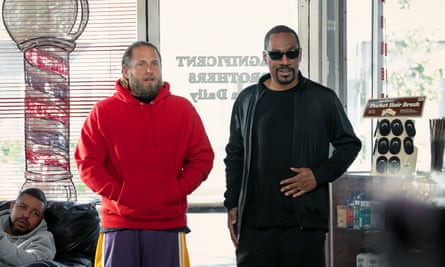 Jennifer Lopez in The Mother. Photograph: Eric Milner
Jennifer Lopez in The Mother. Photograph: Eric MilnerWhat can we learn from Netflix’s biggest viewership data reveal ever?
The streaming platform has shared its most in-depth look at what their many subscribers have been watching
Jesse Hassenger
Wednesday 13 December 2013
I
So what, exactly, are the biggest shows and movies on Netflix? Many of the most popular shows feature or are aimed at young women. Anyone with access to social media or a Hot Topic will probably know that Wednesday, the service’s Addams Family-as-YA reboot, is a huge success; less merchandised but similarly high up the Netflix charts are Ginny & Georgia (essentially Netflix’s in-house Gilmore Girls), Outer Banks (a teen mystery series), Firefly Lane (a decades-spanning drama of female friendship), and the Korean drama series Crash Course in Romance. There’s also plenty of escapist action-adventure fare, like FUBAR (a father-daughter action-comedy with Arnold Schwarzenegger that plays a bit like a True Lies sequel) and the limited series Kaleidoscope (a time-scrambled heist drama whose episodes can be watched in any order); plus more serious action-intrigue like The Night Agent (the most-watched Netflix Thing for this entire six-month period) and The Diplomat (with Keri Russell as a newly appointed US ambassador).
There are neat little quirks to these charts: Kaleidoscope and The Diplomat both feature Rufus Sewell, suggesting a heretofore untapped appetite for an actor who usually plays scheming counts. But apart from the unique structure of Kaleidoscope that takes advantage of the streaming format, none of these shows would be especially difficult to picture on the network television of old. Indeed, for all of Netflix’s technological innovation and digital-world dominance, many of its biggest hits feel like throwbacks to somewhere around the turn of the most recent century, circa 24-era Fox and the dawn of the CW.
Echoes of that era emerge from the movie side, too, where chart-toppers The Mother (action-drama glorification of Jennifer Lopez), Murder Mystery 2 (Adam Sandler/Jennifer Aniston marital comedy), Extraction 2 (starring Chris Hemsworth, but with muscular retro-Schwarzeneggerian punch) and You People (Eddie Murphy in a culture-clash comedy) feel like they could have been theatrical-release hits somewhere around the year 2000. Not big hits, mind, but the kind of respectable theatrical successes that would go on to rent surprisingly well at Blockbuster for months after their VHS release.

Gabriel Basso in The Night Agent. Photograph: Dan Power
This makes sense: Netflix has enormous reach, so their regular quests for Oscar glory are rarely going to be their most popular attractions (though last year’s awards success All Quiet on the Western Front evidently did well). The service hasn’t supplanted network TV or mainstream movies so much as created a convenient substitute for them – though to some, it may feel as if some kind of greater cultural ubiquity is still missing from these enormous-in-theory hits. Be honest: despite their obvious popularity, there’s almost certainly a movie or TV show mentioned in the above two paragraphs that you’d literally never heard of. (For me, it was Kaleidoscope.)
The numbers may hold the explanation for that void – though not necessarily in the way Netflix intends. The data on their spreadsheet measures viewership in individual hours watched, rather than tickets sold, or actual number of people watching. In other words, it uses a metric that is nearly impossible to compare with any other media not using this cockamamie system. Take The Mother, and its nearly 250m hours viewed. How does that compare with a traditional theatrical release? Well, The Mother is about two hours, so maybe 125 million people worldwide watched it. But even sampling a few minutes of the movie will count toward that huge time-logging total, so a genuine viewership of 125 million is probably high – especially considering that this would mean half of their entire global subscriber base of approximately 240 million people watched a Jennifer Lopez revenge movie within six weeks of its release. Presuming too many partial watches also involves way too many users to sound plausible. (For example, 100m hours would still require 200 million viewers to watch 30 minutes of a movie.)
What we’re left with is still pretty much a guess, with the broadest of guidance and general common sense indicating that maybe 50 million people or so might have watched The Mother in full during May and June 2023. For a theatrical release, this would be impressive, indicating something on par with the global release of the recent Mission: Impossible sequel. Then again, new Mission: Impossible movies can’t conceivably rack up millions of autoplayed hours if enough account owners fell asleep on the couch while watching something else. Similarly, 500m hours of Wednesday could mean that its eight episodes were all watched by an audience twice the size of Seinfeld in 1996, or that tons of people sampled the pilot, or that its biggest fans watched the series many times through for comfort.
The real question is, why do some of us yearn to make these comparisons? Is it just nostalgia for checking those comprehensive Nielsen charts in the 1990s, when viewership numbers were actually impressive? On one hand, Netflix’s tendency to self-report all of its stats, whether in vague press releases or specific data dumps (that are also still pretty vague), demonstrates its tech-company bona fides, in the sense that it’s all potential bullshit. This vast company has helped upend how movies and TV shows are made, yet hard data about their actual success in reaching viewers more or less amounts to “trust us”.

On the other hand, the craving for data that accompanies so much writing about Netflix is a little perverse. (Put another way: probably a lot of people a quarter-century ago could name the most popular TV shows through a combination of their own viewing habits, social cues and magazine covers, not checking the Nielsen numbers.) Box office analysis is more of a spectator sport than ever, with its own weird caveat that a lot of the spectators seem to want to charge into the announcer booth and start calling the game themselves – at least judging by how widely some of this information is shared with a kind of deranged glee. Have you heard that Aquaman and the Lost Kingdom is in financial trouble? It would make sense if you hadn’t, considering that it’s not commercially available for another week. Yet reporting on estimates of estimates of estimates has reporting (and fans) calling time of death on movies before they’re even out.
If nothing else, this Netflix data rejects that model of breathlessness. Instead of making a box office call two weeks before a movie is released, they’re waiting for six months of accumulation, which shows the long-tail catch-up of earlier seasons of their biggest hits outperforming plenty of new stuff. At the same time, the knowledge of which movies and shows command a greater audience than kids rewatching Sing 2 may not prove entirely satisfying. Box office hits may be an old-fashioned notion, and more niche-driven than ever with hyper-targeted events like Five Nights at Freddy’s, but they also feel pretty definitive: people saw this. Going to the movies yourself offers more evidence, albeit anecdotal: my showing was packed, or I was the only one there.
Streaming TV and especially movies don’t have the same feedback, while at the same time, the socialized internet demands more of a verdict than ever; declaring a movie a hit or a flop fits snugly into the confines of a tweet. Not knowing how many other people are sharing your experience – or having an experience that you should check out yourself – isn’t necessarily a bad thing, but it’s a tough habit to break. (There’s also a hack for that, at least with one medium: go to the movies.) Nielsen and box office charts may be the simple results of a popularity contest, but they also functioned as cultural cheat sheets, letting readers know what they might get up to in their downtime, if they don’t have strong opinions or tastes of their own. Netflix is trying to provide a little of that on their own terms. For the most part, though, their solution is characteristic of a service that often comes across like network TV crossed with giant digital pacifier: watch it all, watch everything, watch whatever. So long as it’s with us.


No comments:
Post a Comment